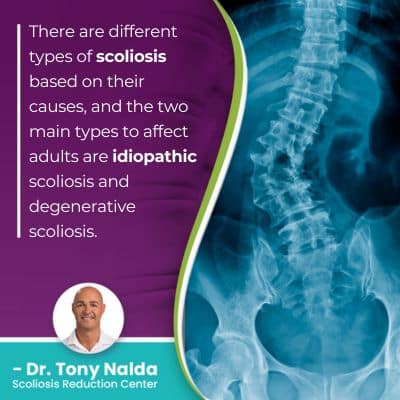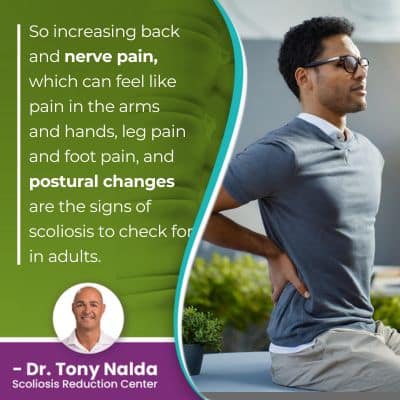Comprehensive Guide: How to Check for Scoliosis in Adults

When it comes to checking for scoliosis in adults, the signs tend to be more overt than in childhood scoliosis. While scoliosis is commonly seen as a childhood condition, the actual rate of scoliosis increases with age; continue reading to learn why.
While scoliosis is more frequently diagnosed in children, it's also important for adults to be aware of the signs of scoliosis. Adult scoliosis is harder to miss than childhood scoliosis because the condition becomes compressive and painful once skeletal maturity has been reached.
The first step to being diagnosed with scoliosis involves recognizing its signs, and the earlier, the better.
Table of Contents
Early Signs of Scoliosis
There are different types of scoliosis, determined by a condition's underlying cause.
The most prevalent type of scoliosis to affect all ages is idiopathic scoliosis, and this type has no known cause and accounts for approximately 80 percent of known diagnosed cases.
Idiopathic scoliosis is the most common type to affect children and adults and is thought to be multifactorial: caused by a number of variables, or a combination of factors that can vary person to person.
As scoliosis develops, an unnatural sideways-bending and rotating spinal curve is developing, and this introduces a lot of uneven forces to the spine, its surrounding muscles and nerves, and the entire body.
 There are different types of scoliosis based on their causes, and the two main types to affect adults are idiopathic scoliosis and degenerative scoliosis.
There are different types of scoliosis based on their causes, and the two main types to affect adults are idiopathic scoliosis and degenerative scoliosis.
Condition Types
The main type of scoliosis to affect all ages is idiopathic scoliosis, and idiopathic scoliosis has no known cause; it's thought to be multifactorial.
The most prevalent type of scoliosis overall is adolescent idiopathic scoliosis, diagnosed between the ages of 10 and 18.
Approximately 80 percent of known cases involve idiopathic scoliosis, and the remaining 20 percent are associated with known causes: neuromuscular scoliosis, congenital scoliosis, and degenerative scoliosis.
Neuromuscular scoliosis tends to be severe because it's caused by a larger neuromuscular condition such as spina bifida, muscular dystrophy, or cerebral palsy.
Congenital scoliosis is a rare type, affecting approximately 1 in 10,000 and is caused by a malformed spine that develops in utero.
The two main types to affect adults are idiopathic scoliosis and degenerative scoliosis.
Idiopathic Scoliosis in Adults
The importance of knowing how to check for scoliosis at every age is important, and the prevalence of idiopathic scoliosis in adults is the perfect example of why.
Cases of idiopathic scoliosis in adults are actually cases of adolescent idiopathic scoliosis that were diagnosed and untreated during adolescence, and these patients' scoliosis progressed with time and maturity into adulthood.
It can be difficult to imagine how an adolescent could live with scoliosis for so long without noticing, but as scoliosis ranges so widely in severity, some forms are mild and difficult to detect.
Scoliosis ranges from mild scoliosis to moderate scoliosis, severe and very severe scoliosis, and mild forms of adolescent idiopathic scoliosis aren't associated with functional deficits, pain, and symptoms can be subtle.
The main sign of scoliosis in adolescents are postural changes such as uneven shoulders and hips, but these types of postural changes can be subtle and difficult for anyone, other than a scoliosis specialist trained in the subtle early signs, to recognize.
Signs of Idiopathic Scoliosis in Adults
One of the main differences between diagnosing scoliosis in children and adults is what brings them in for a diagnosis; with children, it's postural changes, and with adults, it's pain.
The most common sign of scoliosis in adults is pain, and this can include back pain and/or nerve pain that radiates into the extremities due to nerve compression.
For children, the spine is experiencing a constant lengthening motion that counteracts the compressive force of the unnatural spinal curve, and compression of the spine and its surrounding muscles and nerves is the main cause of condition-related pain.
So for adolescents with mild scoliosis, it's not uncommon that it goes unnoticed until the patient reaches skeletal maturity and the condition becomes compressive and painful; pain is what brings most adults in to see me for a diagnosis and treatment.
Adults also experience postural changes such as a prominent lean to one side that's most noticeable when they bend forward, but pain is the most noticeable sign of adult scoliosis.
The next most prevalent type of scoliosis in adults is degenerative scoliosis.
Degenerative Scoliosis
Degenerative scoliosis affects older adults and is caused by natural age-related spinal degeneration.
It's also known as de novo scoliosis, meaning no previous history with the condition, unlike idiopathic scoliosis in adults.
Degenerative scoliosis is more prevalent in females due to hormone and bone density changes caused by menopause.
Although scoliosis is more often diagnosed in children, the actual rate of scoliosis increases among the aging population, and this is due to degenerative scoliosis affecting older adults.
While progression can slow once the progressive trigger of growth is removed, once the spine starts to degenerate, it can become increasingly unstable and unbalanced.
Degenerative Disc Disease
Most spinal degeneration starts in the intervertebral discs; an intervertebral disc sits between vertebral bodies and provides cushioning, structure, flexibility, and acts as the spine's shock absorbers.
As a disc degenerates, it tends to lose height, change shape, and this affects the position of adjacent vertebrae attached, disrupting the spine's ability to maintain its natural curves and neutral alignment.
 A focus of treatment for degenerative scoliosis is reducing the size of the curve back to where it was prior to becoming painful, whereas the goal of childhood scoliosis treatment is to achieve as significant a curvature reduction as possible to counteract curve progression triggered as a child grows.
A focus of treatment for degenerative scoliosis is reducing the size of the curve back to where it was prior to becoming painful, whereas the goal of childhood scoliosis treatment is to achieve as significant a curvature reduction as possible to counteract curve progression triggered as a child grows.
So increasing back and nerve pain, which can feel like pain in the arms and hands, leg pain and foot pain, and postural changes are the signs of scoliosis to check for in adults.
When a patient leans forwards, the spine is highly visible, as are any trunk asymmetries, so an Adam's forward bend test is a common screening exam for scoliosis.
Adult Scoliosis Treatment Options
When it comes to treating idiopathic scoliosis in adults, the reality is that had these patients received a diagnosis and treatment during adolescence, their spines would be in far better shape than they are by the time they see me.
A focus of treatment is pain relief, reducing the size of the scoliotic curve as much as possible to prevent curve progression, increasing condition effects, and the need for invasive surgical treatment options.
Chiropractic techniques and adjustments are applied as part of a conservative nonsurgical treatment approach to impact the condition on a structural level, and physical therapy can help address muscle weakness, muscular imbalance, abnormal posture, and most importantly, it can increase core muscle strength so the spine can be optimally supported and stabilized by its surrounding muscles.
Corrective bracing can help with short-term pain relief and spinal stability, and rehabilitation can involve continued chiropractic care, a variety of therapies, and leading a scoliosis-friendly lifestyle that involves regular scoliosis-specific exercises performed to further stabilize and heal the spine.
As degenerative scoliosis affects older adults, the treatment focus is more about increasing spinal stability, pain management, and preserving existing spinal strength and function.
Physical therapy and the use of scoliosis-specific exercises can be particularly helpful as a facet of degenerative scoliosis treatment; increasing circulation can improve the health of the spine's intervertebral discs.
As the discs don't have their own vascular supply, it can be difficult for them to restore and rejuvenate themselves after damage, but as they absorb nutrients needed from their surroundings, increasing circulation increases blood flow around a damaged disc, making the oxygen and nutrients needed for repair more available.
Conclusion
When it comes to checking for scoliosis, the earlier scoliosis is diagnosed and treatment is started, the better; as a progressive condition, where a scoliosis is at the time of diagnosis doesn't mean that's where it will stay.
So knowing the condition's early signs at every age is beneficial, and when it comes to adult scoliosis, we're talking about back pain, arm and/or leg pain, tingling sensations in the hands and/or feet due to nerve compression and/or nerve damage, and postural changes.
Changes to balance, coordination, and gait are additional signs of scoliosis to watch for, and treatment started as close to the time of diagnosis as possible has its benefits.
Scoliosis gets more complex to treat the more it progresses; spinal rigidity increases, making the spine less responsive to treatment, and making it difficult for some patients to perform key therapeutic exercises as part of treatment.
How noticeable scoliosis is depends on a number of factors (patient age, condition type, severity, and curvature location).
Scoliosis can develop in any of the spine's main sections: cervical spine (neck), the thoracic spine (middle/upper back), and the lumbar spine (lower back), or in more than one section as a combined scoliosis.
In most cases, the area of the body located the closest to the affected spinal section is the most likely to feel its direct effects; for example, an adult with lumbar scoliosis can develop sciatic nerve pain as a related complication, so pain can be felt anywhere along the sciatic nerve's extensive pathway throughout the lower body.
People with scoliosis experience it differently, and how noticeable it is will depend on patient age, and a number of other factors.
In most cases of adult scoliosis, checking for changes to posture, balance, movement, and mainly pain is the best way to reach a diagnosis and treatment.
Dr. Tony Nalda
DOCTOR OF CHIROPRACTIC
After receiving an undergraduate degree in psychology and his Doctorate of Chiropractic from Life University, Dr. Nalda settled in Celebration, Florida and proceeded to build one of Central Florida’s most successful chiropractic clinics.
His experience with patients suffering from scoliosis, and the confusion and frustration they faced, led him to seek a specialty in scoliosis care. In 2006 he completed his Intensive Care Certification from CLEAR Institute, a leading scoliosis educational and certification center.
About Dr. Tony Nalda
 Ready to explore scoliosis treatment? Contact Us Now
Ready to explore scoliosis treatment? Contact Us Now





